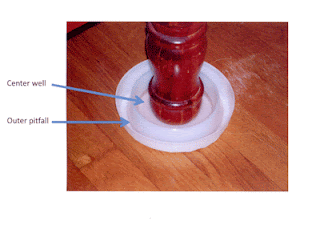 Five days and 27 pages of hand-scribbled notes later and I've returned from another Entomological Society of America annual conference. As usual, the meeting was an exhausting marathon of meetings and posters and mixers, sweetened by renewed personal contacts and much new and useful information about entomology and pest control.
Five days and 27 pages of hand-scribbled notes later and I've returned from another Entomological Society of America annual conference. As usual, the meeting was an exhausting marathon of meetings and posters and mixers, sweetened by renewed personal contacts and much new and useful information about entomology and pest control.Some of the sessions were probably topics only an entomologist would find fascinating, like measurements of insect diversity on Arizona mountaintops, how mosquitoes locate their hosts, or the history of DDT (which cost only $.18/ lb after WWII and even the famous Winston Churchill called "the miraculous powder"!). Nevertheless, there was much information that would be of great practical interest to a gathering of PMPs. Just a few valuable new insights and reports included:
- An update was given on colony collapse disorder (CCD) of honey bees by Diana Cox Fisher, a researcher from Pennsylvania State University, who believes that a combination of stresses and new, or re-emerging, diseases (not pesticides) is probably responsible for the current crisis in bee deaths--at least in the U.S. Currently the best correlation with CCD seems to be a disease known as Israeli Acute Paralytic Virus, although the jury is still out on this one. She noted at the end of her presentation that one out of every three bites of food that we eat is thanks to pollinators like the honey bee.
- Several interesting papers were presented on bed bugs. Mike Potter, of the University of KY, noted in his talk on the history of bed bugs, that within 5 years of the introduction of DDT, researcher John Osmun of Purdue University reported that it became nearly impossible for researchers to locate bed bug infestations to study. Tim McCoy, of Virginia Cooperative Extension, noted the importance and effectiveness of dusts as a tool in bed bug control. Tempo dust, Drione, and Tri-die dusts gave the fastest kill of all products (45 minutes to 6 hrs). Boric acid dust was the slowest, requiring over 18 days to kill. Dini Miller of Virginia Tech concluded that hydroprene was a useful additive to conventional sprays for bed bugs (especially resistant populations), though the effects of hydroprene are subtle and may not become evident until the second or third generation.
- One of the most interesting bed bug talks was given by Changlu Wang of Purdue
 University. He compared spray-based and dust-based IPM programs for bed bugs. The liquid spray tested was chlorfenapyr, and the dust-based program used diatomaceous earth and an innovative bed bug interceptor device placed under bed posts to trap the varmits when they try to climb up, or down from the bed. The clever traps are being sold by Susan McKnight Inc. under the trade name Climbup™ Insect Interceptor. Both spray and dust-based programs worked well in Wang's tests. The traps caught more bed bugs than were observed by the inspectors in all apartments. Another interesting observation was that 94% of the trapped bed bugs were in the outer bowl, indicating that they were off the bed. This shows the importance of treating off-bed locations when controlling bed bugs. These devices might be especially useful for clients with low budgets and a high motivation to help with the elimination program. Of course the effectiveness of the bowls depends on eliminating contact of the bed and bedding with the floor and walls.
University. He compared spray-based and dust-based IPM programs for bed bugs. The liquid spray tested was chlorfenapyr, and the dust-based program used diatomaceous earth and an innovative bed bug interceptor device placed under bed posts to trap the varmits when they try to climb up, or down from the bed. The clever traps are being sold by Susan McKnight Inc. under the trade name Climbup™ Insect Interceptor. Both spray and dust-based programs worked well in Wang's tests. The traps caught more bed bugs than were observed by the inspectors in all apartments. Another interesting observation was that 94% of the trapped bed bugs were in the outer bowl, indicating that they were off the bed. This shows the importance of treating off-bed locations when controlling bed bugs. These devices might be especially useful for clients with low budgets and a high motivation to help with the elimination program. Of course the effectiveness of the bowls depends on eliminating contact of the bed and bedding with the floor and walls. - Tom Greene of the IPM Institute (organization running the Green Shield™ certification program for pest control businesses) reported results of a University of Florida study that showed that properly installed doorsweeps can reduce pest complaints in schools by up to 65%. He made an observation that I believe applies not just to school IPM programs, but to all professional IPM: "The question is not 'do you do IPM?', but 'how much IPM do you do?'" Most PMPs say they do IPM, but there is generally much room for improvement of the quality and depth of IPM done by professionals.

